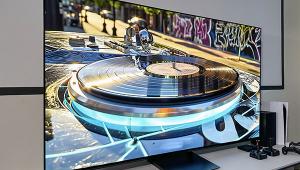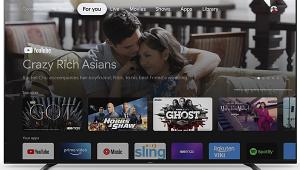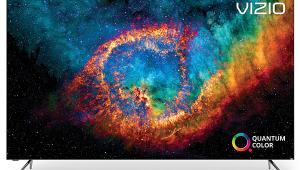Vizio RS65-B2 LCD Ultra HDTV Review Update: January 18, 2016
Since our review for the February/March print edition went to press, the standards for the upcoming Ultra HD Blu-ray format have been clarified. One of these standards specifies that discs produced in this format and offering high dynamic range must include the open HDR10 standard. (HDR isn’t required on UHD Blu-ray discs, but we suspect that many if not most titles will offer it.) Dolby Vision (the other major competitor for HDR at present) may also be included but it’s not required and if included must be in addition to HDR10. Samsung’s upcoming UHD Blu-ray player will support only HDR10.
The Vizio RS65-B2 can currently accommodate only Dolby Vision HDR, and would require an update to handle HDR10. Vizio has stated that this could be done in firmware only, including the needed conversion of its current HDMI 2.0 inputs to the HDMI 2.0a connections required by HDR10. But it has not yet not announced such an update, and clarified in statements to us that they believe Dolby Vision offers a superior HDR solution.
In addition, shortly after our review was sent to Vizio for fact-check (and then, off to the printer), Vizio told us they were working on a firmware update to further improve the set’s already excellent black level performance and address some of the observations in our review. Our review sample downloaded that update (v1.0.10) in mid-January 2016, prompting another round of evaluation. The first noticeable change was that, after installation, the screen will now do go to full black when presented with a full black image, such as fade-outs between scenes. But how will this impact a comparison of this set with some of the best black level performers of the past and present?
I began with old faithful, my 1080p reference Panasonic TC-65ZT60. While that plasma set has been off the market for nearly three years now, it has (up to now) not been bettered in either black level or shadow detail by any set I’ve tested.
Setting up a comparison of any two sets, particularly when dealing with picture elements at black or near black, is not simple. For starters, the controls on most commercial sets that affect their black and near black performance (particularly the Brightness and Gamma adjustments) offer gradations too coarse for critical matching—though generally sufficient for day-to-day viewing. In addition, LCD sets such as the Vizio perform very differently than do self-emissive displays, including plasmas and OLEDs, as the peak white level of a source increases. I did my best to match the two sets, but for these reasons perfect matching will always be impossible. If I had to err because the given control settings were never spot on, I tried to deviate toward the side of slightly crushed blacks (but never by more than one step on the Brightness control). This would have the effect of losing some subtle shadow detail in near-black images, but deliver the best black level the sets could produce.
All of the tests were performed with the sets side-buy-side in a totally darkened room, each of them driven by one of the dual HDMI outputs on an Oppo BDP-105D Blu-ray player (meaning of course that the source material was Blu-ray only). While the differences described here were not always as obvious in subdued room lighting, may of them were, even if not to the same degree.
I went immediately to Harry Potter and the Deathly Hallows Part 2. No source material I have yet found presents greater shadow detail and black level challenges to any HDTV or UHDTV than this; its entire last 90 minutes is a black level and shadow detail nightmare.
On a full black raster field, the firmware-revised Vizio went to total black and disappeared into the room’s blackness, suggesting complete deactivation of the backlight, while the Panny’s screen was still clearly visible as a mid-dark gray. But on most scenes having both dark elements and brighter highlights (true of most dark movie scenes), the two sets ran neck and neck and neck, with the Vizio excelling by a hair on some selections and the Panasonic pulling ahead a bit on others.
On the most challenging sequences, however, the Panasonic took the prize. It exceeded the Vizio by a nose on shadow detail. At the beginning of chapter 12, Voldemort and his minions stand on a bluff overlooking Hogwarts as the (CGI) camera pans around them. As I noted in the review, the Vizio performed very well in this scene, but the Panasonic had finer gradations of detail in the darkly lit areas. This was reinforced on another shot that followed immediately, with Hogwarts in the gloomy background. The spires and details on the buildings, though cloaked in dark shadows, were clearly visible on the Panasonic but less well delineated on the Vizio.
Earlier, at about 31:39 into the film, Harry and his friends travel through a secret tunnel leading to Hogwarts. At one point the sequence changes from a near close-up to a more distant shot, the latter showing the characters at center screen surrounded by black gloom on all sides. On this shot the Vizio went to a brighter gray, at the same time showing the black bars (which were largely invisible, on both sets, most of the time). But the Panasonic remained near-black, as before. I could bring the two sets closer by reducing the Brightness control on the Vizio by one step on this scene, but this made other scenes look a bit too crushed and contrasty. Not by much, though, and many viewers might see the result as a more than acceptable compromise. The culprit here (as mentioned earlier) might have simply been gradations in the set’s Brightness control that were too-coarse to achieve a better balance on such difficult material.
I also later ran a similar comparison between the Vizio and LG’s 65EF9500 OLED. The results weren’t dramatically different on many scenes, but in some important respects the OLED excelled. It went to black faster on full field black scenes than the Vizio. The Vizio took a fraction of a second to go to black (slow enough to see and mention but not so slow as to matter on real-world program material), while the OLED dropped to black immediately. While the two sets’ performances on most star fields were both impressive, these scenes generally favored the OLED—sometimes subtly, sometimes significantly. At about 00.56 into Prometheus, a planet sits below screen center with its horizon brightly lit. Stars are above it, standing out against the inky black of space. The stars on the OLED were noticeably brighter on this scene.
We’ll have more on the OLED vs. Vizio comparison in our upcoming LG 65EF9500 review. The Vizio performed better than any other 4K full-array backlit set we’ve tested so far, but even its 384 locally dimmed zones aren’t quite enough to match self-illuminating designs such as plasma and OLED across the board. But the RS65-B2 does offer admirable black level performance along with brightness levels that today can only be achieved with an LCD set using full LED and/or quantum dot backlighting.





























































